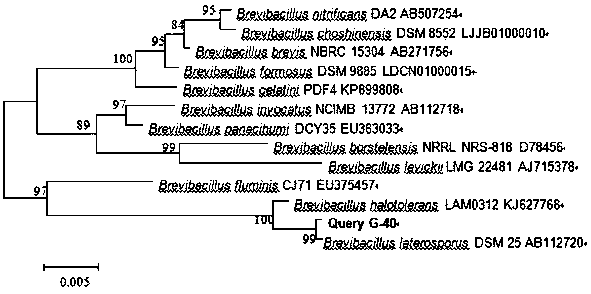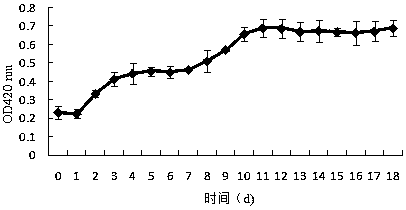Strain of petroleum aromatic hydrocarbon degrading bacterium and applications thereof
A technology for aromatic hydrocarbons and degrading bacteria, applied in the field of microbial degradation of petroleum pollutants, to achieve high-efficiency and rapid degradation capabilities, good application prospects and economic value, and the effect of a wide range of temperatures
- Summary
- Abstract
- Description
- Claims
- Application Information
AI Technical Summary
Problems solved by technology
Method used
Image
Examples
Embodiment Construction
[0025] The present invention screens and confirms the bacterial strain type through the following methods, and provides various excellent properties of the bacterial strain at the same time, and the specific content is as follows:
[0026] 1 Materials and methods
[0027] 1.1 Collection of oil-contaminated soil samples
[0028] The oil-contaminated soil samples came from the oil-contaminated soil in the oil production area of Qianjiang Guanghua Oilfield.
[0029] The moisture content of the polluted soil was determined to be 35%, and the pH value was 8.0.
[0030] 1.2 Medium
[0031] 1.2.1 Inorganic salt medium
[0032] NaNO 3 1.5 g, (NH 4 ) 2 SO 4 1.5 g, K 2 HPO 4 1.0 g, MgSO 4 ·7H 2 O 0.5 g, KCl 0.5 g, NaCl 5.0 g, FeSO 4 ·7H 2 O 0.01 g, CaCl 2 0.02 g, 1000 mL distilled water, pH7.0, 0.5% petroleum, 100 mL per Erlenmeyer flask.
[0033] 1.2.2 Bacterial selective medium
[0034] Beef extract 5.0 g, peptone 10.0 g, NaCl 5.0 g, agar 20 g, sterile nystatin 5...
PUM
| Property | Measurement | Unit |
|---|---|---|
| diameter | aaaaa | aaaaa |
Abstract
Description
Claims
Application Information
 Login to View More
Login to View More - R&D
- Intellectual Property
- Life Sciences
- Materials
- Tech Scout
- Unparalleled Data Quality
- Higher Quality Content
- 60% Fewer Hallucinations
Browse by: Latest US Patents, China's latest patents, Technical Efficacy Thesaurus, Application Domain, Technology Topic, Popular Technical Reports.
© 2025 PatSnap. All rights reserved.Legal|Privacy policy|Modern Slavery Act Transparency Statement|Sitemap|About US| Contact US: help@patsnap.com



